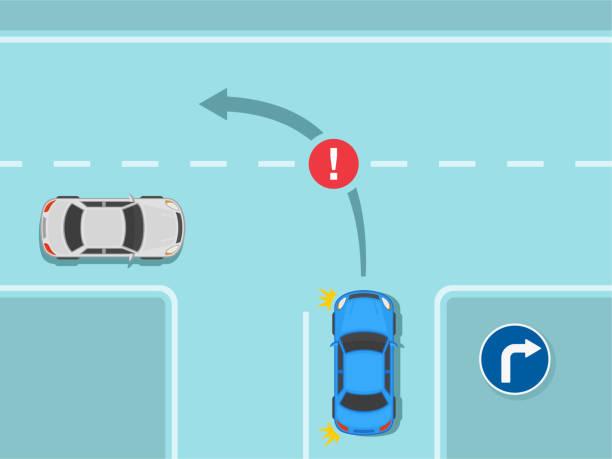Making a left turn might seem like a simple maneuver, but it’s one of the most dangerous actions a driver can take on the road. Whether it’s at a traffic light, an intersection, or even a private driveway, left-turn accidents happen frequently and often result in serious injuries. But when a left-turn collision occurs, who is at fault? Is it always the driver making the turn, or can the other party share some responsibility? We’ll dive deep into the complexities of Left-Turn Fault and what determines liability in such cases.
Understanding Left-Turn Accidents
Left-turn accidents typically happen when a driver making a turn crosses the path of oncoming traffic. This can occur at:
Signalized intersections
Stop sign-controlled intersections
Uncontrolled intersections
Private driveways or parking lots
Since turning left requires the driver to cross multiple lanes of traffic, the risk of misjudging speed or distance is high. This is why left-turn accidents often result in T-bone or head-on collisions, both of which can be catastrophic.
General Rule: The Left-Turning Driver is Usually at Fault
In most cases, the driver making the left turn is held responsible for the accident. Why? Because traffic laws typically require left-turning drivers to yield to oncoming vehicles, pedestrians, and cyclists. If a left-turning driver fails to yield and crashes into another vehicle, they are usually considered negligent.
However, there are some exceptions where the other driver may be at fault or share responsibility.
When the Other Driver May Be at Fault
While the left-turning driver is usually presumed at fault, there are scenarios where the other driver may be partially or fully responsible. Some examples include:
1. Speeding by the Oncoming Driver
If the oncoming driver was speeding excessively, they may bear some or all of the fault. For example, if a vehicle is traveling at 80 mph in a 40 mph zone, the left-turning driver may have miscalculated the time available to turn safely.
2. Running a Red Light
If the oncoming driver ran a red light and collided with a left-turning vehicle that had a green arrow, the oncoming driver would likely be held responsible.
3. Distracted or Impaired Driving
If the oncoming driver was texting, intoxicated, or otherwise distracted and failed to react in time, they could be at fault for the accident.
4. Sudden Lane Changes
Sometimes, an accident occurs because the oncoming driver suddenly changes lanes or swerves unexpectedly, giving the left-turning driver little time to react.
Comparative Negligence: When Both Drivers Share the Blame
In some cases, both drivers may be partially responsible for the accident. This is where comparative negligence comes into play. Many states follow a comparative negligence system, meaning fault is assigned in percentages. For example:
If the left-turning driver failed to yield, but the oncoming driver was speeding, the court may assign 70% fault to the left-turning driver and 30% to the speeding driver.
If the oncoming driver ran a red light while the left-turning driver was making an illegal turn, both could share liability.
How to Prove Fault in a Left-Turn Accident
If you’re involved in a left-turn accident, proving fault is critical. Here are some ways to determine liability:
1. Traffic Signals and Road Signs
Was the left-turning driver obeying traffic signals? Did the oncoming driver have a red light? These factors play a major role in determining fault.
2. Witness Statements
Independent witnesses can provide unbiased accounts of how the accident occurred, which can be crucial evidence.
3. Surveillance and Dash Cam Footage
Many intersections have traffic cameras that may have captured the accident. Dash cam footage can also help establish what really happened.
4. Police Reports
If the police were called to the scene, their accident report could indicate who was at fault based on their findings.
5. Vehicle Damage Analysis
The point of impact and type of damage on the vehicles can reveal the angle and speed at which the accident occurred.
How to Avoid Left-Turn Accidents
While left-turn accidents are common, they can be avoided with cautious driving. Here are some tips:
Always yield to oncoming traffic: Even if you think you have enough time, wait until you’re sure it’s safe to turn.
Use turn signals: Signaling early allows other drivers to anticipate your move.
Be mindful of blind spots: Check for pedestrians and cyclists before turning.
Avoid rushing through yellow lights: Many accidents occur when drivers try to “beat” the light.
Consider alternative routes: If possible, use intersections with dedicated left-turn signals to reduce risk.
FAQs About Left-Turn Accidents
Q1: Is the left-turning driver always at fault?
Not always. While the left-turning driver is typically responsible, factors like speeding, running a red light, or distracted driving by the other driver can shift liability.
Q2: What if I had a green arrow while turning left?
If you had a green arrow and the oncoming driver hit you, they would likely be at fault since you had the legal right of way.
Q3: Can I get compensation if I was partially at fault?
Yes. In states with comparative negligence laws, you may still recover damages based on your percentage of fault. However, your compensation may be reduced accordingly.
Q4: What should I do after a left-turn accident?
Immediately check for injuries, call the police, take pictures, gather witness statements, and exchange insurance information with the other driver.
Q5: Should I contact a lawyer after a left-turn accident?
If there are injuries, significant damages, or disputes about fault, consulting a lawyer can help protect your rights and ensure fair compensation.
Conclusion
Left-turn accidents are among the most complex when it comes to determining fault. While the left-turning driver is usually considered responsible, other factors—such as speeding, running a red light, or reckless driving—can shift liability. If you ever find yourself in such an accident, gathering evidence and understanding traffic laws can make a huge difference in proving your case. Drive safely, stay alert, and always yield when in doubt to avoid becoming another statistic in left-turn collisions. If you’ve been involved in a left-turn accident and need legal advice, don’t hesitate to seek professional help. Understanding Left-Turn Fault can make all the difference in ensuring you get the justice and compensation you deserve.




